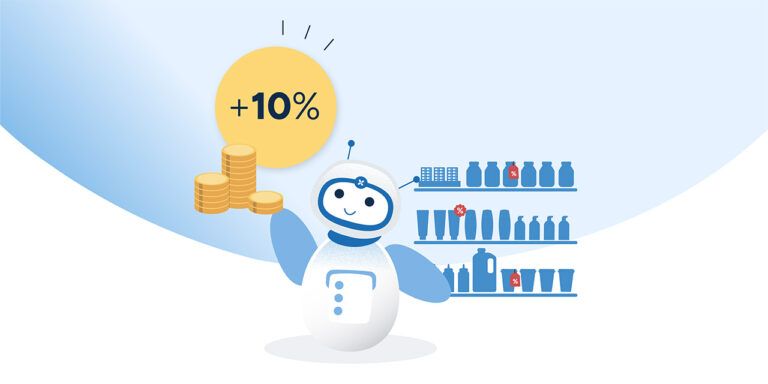Unified pricing and promotion planning: the key to pricing precision and powerful promotions
Dec 1, 2023 • 5 min
In today’s retail landscape, pricing and promotions are universally acknowledged as key merchandising levers and critical components of a successful business strategy.
However, many retailers grapple with managing these areas separately, leading to inefficiencies and missed opportunities. Unified pricing and promotion planning addresses this challenge by consolidating these functions into one platform. This approach allows retailers to streamline their processes, reduce errors, and ultimately achieve better results.
Let’s look at a fictional retailer set within a strikingly real-world scenario: SwiftMart, a large, respected retailer, observed declining margins and a deteriorating customer experience due to a persistent gap between their pricing and promotions teams.
Decisions on pricing were often disconnected, resulting in inconsistent and confusing price tags across various products. The promotions team’s initiatives often clashed with product pricing, ruining the pricing team’s efforts at maintaining a low everyday price strategy.
For example, the promotions team would roll out what they felt were “exciting” campaigns without consulting their pricing colleagues, forcing the latter to upend their plans and disrupt upcoming price activity. All this confusion created both operational inefficiencies and irritated customers.
Recognizing the need for change, SwiftMart sought a technological solution to unify the processes used by these critical teams. By using the same technology across their teams, they were able to seamlessly align pricing and promotions, ushering in an era of consistent pricing, effective promotions, and heightened customer satisfaction.
Benefits of unifying price, promotion, and markdown optimization
Some retailers may be hesitant to unify price and promotions planning. For example, they may worry that unifying the two functions will require significant changes to existing processes and systems. They may also have concerns that stem from issues with their existing processes, such as a lack of visibility between teams’ planning that makes change feel like a risk.
However, the process of unifying these functions under one platform brings a host of benefits. In fact, the pain points that are alleviated are often the very same ones that retailers feared would get worse with unification.
Here are some of the advantages of unifying pricing and promotions:
Improved accuracy and consistency
By unifying pricing and promotion planning, retailers can ensure that their pricing and promotional strategies are aligned. This can help to avoid conflicts and inconsistencies across teams, leading to more accurate and consistent pricing and promotions, leading to more effective and efficient use of resources like time, capital, and manual work.
Enhanced visibility and control
With a unified approach, retailers can have greater visibility and control over their planning. A unified system can ensure that promotions don’t clash with pricing decisions and that key metrics like margins are managed properly.
Better control over the overall pricing lifecycle
Unifying pricing and promotion planning can create synergies with other parts of the pricing lifecycle, such as end-of-life markdowns. By having a holistic view of pricing and promotions, retailers can make more informed decisions and optimize their pricing strategies throughout a price’s lifecycle.
3 key features of unifying pricing and promotion planning
Of course, understanding the benefits of unifying pricing and promotions is only one piece of the puzzle. The second is finding the right system to help these teams work together smoothly. Here are some key features to consider when searching for a software solution:
1. Unified data integration
To effectively unify pricing and promotion planning, you need to have real-time data integration across all relevant systems. This means that pricing and promotion teams should have access to the same data and be able to make decisions based on the same information.
Let’s say SwiftMart, our large retailer from earlier, has planned an ongoing promotion for orange juice. Due to supply issues, the lead time for the product has become longer than the time until projected stockout of the product. Without unified data integration, the promotion team may not be aware of the inventory issue and could continue with the promotion, leading to stockouts and lost sales.
However, with integration across all relevant systems, the pricing and promotion teams at SwiftMart have access to the same forecasting and replenishment information. Together, they can decide whether to adjust the promotion or pricing strategy or end the promotion early to adjust for the foreseen replenishment issue.
2. Alignment on rules and constraints
It’s also important to consider any strategic or legal constraints impacting pricing and promotion planning. For example, in the EU, the Omnibus Directive sets guidelines for pricing practices. A retailer may also have made legally binding agreements with suppliers that lock in upcoming price and promotional decisions. By aligning the legal and strategic constraints between the pricing and promotion teams, retailers can avoid potential legal issues and ensure their pricing strategy is compliant.
Let’s say SwiftMart has been experiencing frequent customer complaints and operational challenges due to rapid price changes on their products. To streamline their operations and enhance customer satisfaction, SwiftMart’s management decides to align on an internal ruleset for pricing.
SwiftMart limits price adjustments to once daily to prevent operational confusion and sets a two-week interval between pricing changes for high-demand items, aligning with the Omnibus Directive’s fair-trade provisions. This strategy simplifies operations and offers customers a more predictable pricing structure, fostering trust and loyalty towards SwiftMart as a reliable retailer committed to consumer satisfaction and regulatory compliance.
3. Automatic price lock
When a retailer decides on a promotion and sets the dates, their pricing system should lock base price changes automatically. By blocking out changes during promotional periods, a retailer can ensure that their pricing strategy remains consistent and that their promotions are effective.
Let’s say SwiftMart wants to run a promotion on a popular brand of cereal. The regular price of the cereal is $4.99 per box, but SwiftMart wants to offer a discount of 20% off during the promotion. The promotion is set to run for one week, from Monday to Sunday.
Meanwhile, the pricing team has decided to increase the base price of the cereal to $5.49 per box on Wednesday to keep up with rising costs. If the base price changes haven’t been locked during the promotional period, the discount will now be less effective, and customers may feel cheated. Or, worse, the price might not be legally compliant with regional laws, putting the company at risk.
However, by locking base price changes during the promotional period, SwiftMart’s discount remains consistent and effective throughout the entire week. This will help attract more customers and increase sales, while also maintaining a consistent pricing strategy.
READ MORE: Discount dynamics: Mastering the art of promotional pricing
Breaking silos: Uniting pricing and promotions
While the advantages of adopting a unified merchandising approach are clear, many retailers have been slow to integrate their pricing and promotions data and decision making. The hesitancy to embrace unified pricing and promotion planning may be attributed to entrenched siloed processes, inventory complexities, resource constraints, and resistance to change. Nevertheless, as businesses increasingly grasp the benefits of an integrated merchandising strategy, a rising trend toward unifying these functions is sure to follow.
And, luckily, tech companies are already well-positioned to support retailers in overcoming these obstacles. There are sophisticated solutions on the market that can streamline pricing and promotion planning, enable granular planning, and make the transition to integration more accessible and efficient.
By aligning these strategies, businesses can boost revenue and profitability, foster customer loyalty, and streamline operations. Adopting a unified approach positions businesses to stay competitive and foster sustainable growth.




